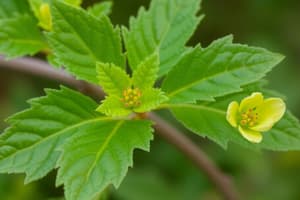Podcast
Questions and Answers
What category of plant includes flowering plants, conifers, ferns, and horsetails?
What category of plant includes flowering plants, conifers, ferns, and horsetails?
- Gymnosperms
- Angiosperms (correct)
- Cryptogams
- Monocots
Which type of plant produces seeds within cones called strobili?
Which type of plant produces seeds within cones called strobili?
- Angiosperms
- Cryptogams
- Gymnosperms (correct)
- Dicots
Which category of plants lacks true roots, stems, leaves, and flowers?
Which category of plants lacks true roots, stems, leaves, and flowers?
- Cryptogams (correct)
- Monocots
- Gymnosperms
- Angiosperms
In which plant classification do the tissues grow directly onto rocks or surfaces?
In which plant classification do the tissues grow directly onto rocks or surfaces?
What unique adaptation allows gymnosperms to thrive in cold climates?
What unique adaptation allows gymnosperms to thrive in cold climates?
How do cryptogams reproduce?
How do cryptogams reproduce?
Study Notes
Overview of Flora and Fauna
Flora is the collective name given to all living plants, while fauna refers to all animals. Together, they form part of our natural world, providing us with oxygen through photosynthesis and acting as primary food sources for many species, including humans. Here's a look into some aspects of both flora and fauna.
Types of Plants
Plant life comes in various forms, from tiny mosses to towering trees, and can be classified according to their reproductive structures. Some key plant classifications include:
- Angiosperms: These are seed-producing plants, which includes flowering plants, conifers, ferns, and horsetails. They have vascular tissue to transport water and nutrients throughout their body.
- Gymnosperm: This type of angiosperm consists of cone-bearing plants such as pine trees and fir trees. Their seeds are produced within cones called strobili.
- Cryptogams: Nonvascular plants like mosses, liverworts, hornworts, and algae belong to this category. They lack true roots, stems, leaves, and flowers; instead, their tissues grow directly onto rocks or other surfaces.
Each classification has its own unique characteristics and adaptations suited for specific environments. For example, gymnosperms thrive in cold climates due to their ability to retain moisture inside needlelike leaves called scales. On the other hand, cryptogams can survive under extreme conditions because they reproduce via spores rather than seeds.
In conclusion, understanding these different types of plants helps us appreciate the vast array of life around us. It also highlights how each organism plays a crucial role in maintaining balance within ecosystems.
Studying That Suits You
Use AI to generate personalized quizzes and flashcards to suit your learning preferences.
Description
Explore the various classifications of plants, including angiosperms, gymnosperms, and cryptogams. Learn about their unique characteristics and adaptations to different environments. Understand how each type of plant contributes to the balance of ecosystems.




